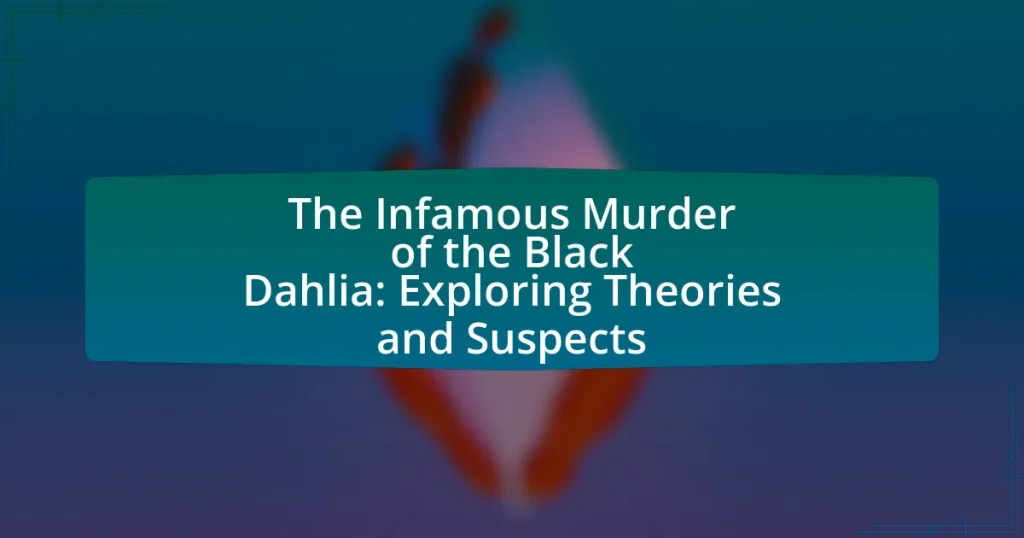The Black Dahlia murder refers to the unsolved homicide of Elizabeth Short, a 22-year-old woman found murdered in Los Angeles on January 15, 1947. The article explores the circumstances of Short’s life, the gruesome details of her murder, and the extensive media coverage that followed, which contributed to her posthumous fame. It examines various theories regarding potential suspects, including George Hodel and Leslie Dillon, and discusses the impact of public interest and speculation on the investigation. Additionally, the article highlights the cultural significance of the case and the lessons learned for modern investigative practices in handling unsolved murders.

What is the Black Dahlia murder?
The Black Dahlia murder refers to the unsolved homicide of Elizabeth Short, a 22-year-old woman found murdered in Los Angeles on January 15, 1947. Short’s body was discovered mutilated and severed in two, leading to widespread media coverage and public fascination. The case remains one of the most famous unsolved murders in American history, with numerous theories and suspects proposed over the decades, but no one has ever been charged in connection with her death.
Who was Elizabeth Short, the Black Dahlia?
Elizabeth Short, known as the Black Dahlia, was an American woman who became famous posthumously after her murder in 1947. Short was born on July 29, 1924, in Hyde Park, Massachusetts, and moved to California in the 1940s, where she pursued a career in acting. Her body was discovered on January 15, 1947, in a vacant lot in Los Angeles, and the case garnered significant media attention due to the gruesome nature of her death and the mystery surrounding it. The investigation into her murder remains one of the most famous unsolved cases in American history, leading to numerous theories and suspects over the years.
What were the circumstances of her life leading up to the murder?
Elizabeth Short, known as the Black Dahlia, faced a tumultuous life leading up to her murder. She experienced a troubled childhood, marked by her parents’ divorce and her father’s abandonment, which contributed to her unstable upbringing. Short moved to Los Angeles in 1943, seeking fame and fortune in the film industry, but struggled to find consistent work as an actress. During this period, she became involved with various men, some of whom had questionable backgrounds. Her lifestyle included transient living arrangements and a series of tumultuous relationships, which may have exposed her to dangerous situations. These circumstances created a backdrop of vulnerability that ultimately culminated in her brutal murder in January 1947, a case that remains unsolved and has fueled numerous theories and speculations.
How did Elizabeth Short become known as the Black Dahlia?
Elizabeth Short became known as the Black Dahlia due to her posthumous nickname, which was popularized by the media following her murder in 1947. The name “Black Dahlia” was derived from a film noir titled “The Blue Dahlia,” and it was used to describe her because she often wore black clothing and had dark hair. The sensational coverage of her gruesome murder by newspapers, particularly the Los Angeles Times, further cemented this moniker in public consciousness.
What are the key details surrounding the murder?
The key details surrounding the murder of Elizabeth Short, known as the Black Dahlia, include her body being discovered on January 15, 1947, in a vacant lot in Los Angeles. The body was severely mutilated, with the cause of death determined to be blunt force trauma and possible strangulation. The case garnered immense media attention due to the gruesome nature of the crime and the mystery surrounding Short’s life and death. Investigators received numerous tips and confessions, but no one was ever charged, leading to various theories and suspects over the years. The case remains unsolved, making it one of the most infamous murders in American history.
When and where was Elizabeth Short found?
Elizabeth Short was found on January 15, 1947, in Leimert Park, Los Angeles, California. Her body was discovered in a vacant lot, and the case remains one of the most infamous unsolved murders in American history.
What were the details of the crime scene?
The crime scene of the Black Dahlia murder was located in Leimert Park, Los Angeles, where the body of Elizabeth Short was discovered on January 15, 1947. The victim’s body was found severed in two, with extensive mutilation, including facial lacerations and organ removal, indicating a high level of brutality. The body was positioned in a way that suggested the killer had taken time to arrange it, with the lower half placed a foot away from the upper half. Additionally, the crime scene was devoid of blood, leading investigators to believe that the murder occurred elsewhere before the body was transported to the scene. These details highlight the calculated nature of the crime and the psychological profile of the perpetrator.
What impact did the Black Dahlia murder have on society?
The Black Dahlia murder significantly impacted society by intensifying public fascination with unsolved crimes and the media’s role in sensationalizing such cases. The brutal nature of Elizabeth Short’s murder in 1947 captured national attention, leading to widespread media coverage that influenced public perception of crime and safety. This case became a cultural touchstone, inspiring numerous films, books, and discussions about crime, gender, and the treatment of women in society. The extensive media coverage also prompted discussions about police procedures and the effectiveness of law enforcement in solving high-profile cases, highlighting societal concerns regarding justice and public safety.
How did the media coverage shape public perception?
Media coverage significantly shaped public perception of the Black Dahlia murder by sensationalizing the crime and focusing on graphic details. This extensive reporting created a narrative that emphasized the mystery and horror surrounding Elizabeth Short’s death, leading to widespread fascination and speculation among the public. For instance, newspapers like the Los Angeles Herald-Express published bold headlines and graphic images, which not only attracted readers but also influenced their understanding of the case as one of intrigue and scandal. This portrayal contributed to the development of various theories and suspects, as the media’s framing encouraged the public to engage in speculation, ultimately embedding the case into popular culture and shaping its legacy.
What cultural significance has the case held over the years?
The case of the Black Dahlia murder has held significant cultural importance over the years, symbolizing the intersection of crime, media sensationalism, and societal fascination with unsolved mysteries. The brutal murder of Elizabeth Short in 1947 not only captivated the public but also influenced various forms of art, literature, and film, establishing a lasting legacy in popular culture. For instance, the case has inspired numerous books, movies, and television shows, reflecting society’s ongoing intrigue with the macabre and the unresolved nature of the crime. Additionally, the Black Dahlia case has become a reference point in discussions about gender, victimization, and the portrayal of women in media, highlighting the societal attitudes of the time and their evolution.

What theories exist regarding the Black Dahlia murder?
Several theories exist regarding the Black Dahlia murder, primarily focusing on various suspects and motives. One prominent theory suggests that George Hodel, a physician, was involved, supported by circumstantial evidence and his own son’s claims. Another theory posits that the murder was linked to the Los Angeles underworld, with organized crime figures potentially involved. Additionally, some theories speculate that the murder was a result of a personal vendetta or a crime of passion, possibly connected to Elizabeth Short’s lifestyle and relationships. Each theory reflects the complexity and mystery surrounding the case, which remains unsolved since Elizabeth Short’s body was discovered in 1947.
What are the most prominent theories about the killer’s identity?
The most prominent theories about the killer’s identity in the Black Dahlia case include the involvement of George Hodel, a physician who was suspected due to circumstantial evidence and his alleged connection to the crime scene. Additionally, some theories suggest that the killer could be a member of the Los Angeles police force, given the potential cover-up and mishandling of the investigation. Another theory posits that the killer was a serial murderer active in the area at the time, with similarities to other unsolved cases. These theories are supported by various investigative reports and analyses conducted over the years, including the work of crime historian and author Steve Hodel, who has extensively researched his father’s possible involvement.
How do these theories differ in their explanations?
The theories surrounding the murder of the Black Dahlia differ primarily in their proposed motives and suspects. For instance, one theory suggests that the murder was committed by a serial killer, emphasizing a pattern of violence against women, while another theory posits that the crime was linked to the victim’s personal relationships, suggesting jealousy or revenge as motives. Additionally, some theories implicate specific individuals, such as George Hodel, based on circumstantial evidence and alleged confessions, whereas others focus on broader societal issues, like the influence of Hollywood culture at the time. These differing explanations highlight the complexity of the case and the various interpretations of the available evidence.
What evidence supports each theory?
Theories regarding the murder of the Black Dahlia, Elizabeth Short, are supported by various pieces of evidence. The theory that George Hodel was the murderer is backed by circumstantial evidence, including Hodel’s alleged obsession with Elizabeth Short and the fact that he was a surgeon, which aligns with the precision of the crime. Additionally, his son, Steve Hodel, has published books detailing evidence such as photographs and witness testimonies that suggest Hodel’s involvement.
Another theory posits that the murder was committed by a serial killer, with evidence drawn from similarities to other unsolved cases in Los Angeles during that time. For instance, the method of dismemberment and the location of the body align with patterns observed in other murders attributed to the same unidentified killer.
The theory involving the involvement of the Los Angeles police is supported by claims of a cover-up, with evidence including reports of police officers having connections to Elizabeth Short and potential suppression of evidence. This theory is bolstered by the lack of progress in the investigation and allegations of corruption within the LAPD during the 1940s.
Each of these theories is supported by specific evidence that connects the suspects or circumstances to the crime, providing a framework for understanding the complexities surrounding the Black Dahlia case.
Why do some theories persist despite lack of evidence?
Some theories persist despite lack of evidence due to cognitive biases, social influences, and emotional attachments. Cognitive biases, such as confirmation bias, lead individuals to favor information that supports their pre-existing beliefs while disregarding contradictory evidence. Social influences, including groupthink and the desire for belonging, can reinforce these theories within communities. Emotional attachments to narratives, particularly in high-profile cases like the Black Dahlia murder, create a compelling story that resonates with the public, making it difficult to abandon these theories even when evidence is lacking. Historical examples, such as the enduring belief in conspiracy theories surrounding unsolved crimes, illustrate how these factors contribute to the persistence of unfounded theories.
What role does speculation play in the ongoing fascination with the case?
Speculation significantly fuels the ongoing fascination with the Black Dahlia case by creating intrigue and encouraging public engagement. The unsolved nature of the murder, combined with various theories about potential suspects, invites individuals to form their own interpretations and hypotheses. This engagement is amplified by media portrayals and popular culture references, which often sensationalize the case, leading to a continuous cycle of interest. For instance, numerous documentaries, books, and films have explored different angles of the case, further embedding it in public consciousness and ensuring that speculation remains a central element of its narrative.
How have new technologies influenced the investigation of these theories?
New technologies have significantly influenced the investigation of theories surrounding the Black Dahlia murder by enhancing forensic analysis and data collection methods. Advances in DNA analysis, for instance, allow investigators to extract and analyze genetic material from evidence that was previously untestable, potentially linking suspects to the crime. Additionally, digital databases and software for pattern recognition enable law enforcement to cross-reference information more efficiently, identifying connections between the Black Dahlia case and other unsolved murders. The use of geographic information systems (GIS) has also improved the ability to analyze crime patterns and suspect movements, providing new insights into the case. These technological advancements have led to a more thorough and informed investigation process, increasing the chances of uncovering new evidence or leads.

Who are the main suspects in the Black Dahlia case?
The main suspects in the Black Dahlia case include George Hodel, a physician who was investigated due to circumstantial evidence linking him to the crime, and Leslie Dillon, a bellboy who was considered a suspect based on his knowledge of the murder details. George Hodel’s son, Steve Hodel, has publicly claimed that his father was the murderer, citing evidence from his investigations. Leslie Dillon was arrested in 1949 but was later released due to lack of evidence. Other individuals, such as Mark Hansen and a few unnamed suspects, were also considered but did not have substantial evidence against them. The case remains officially unsolved, with no definitive conclusion on the identity of the murderer.
What evidence links specific suspects to the murder?
Evidence linking specific suspects to the murder of Elizabeth Short, known as the Black Dahlia, includes witness testimonies, forensic analysis, and circumstantial evidence. For instance, George Hodel, a primary suspect, was linked through witness accounts that placed him near the crime scene and through his son’s claims that Hodel confessed to the murder. Additionally, forensic evidence such as the unique manner of the body’s mutilation suggested a level of anatomical knowledge, which aligned with Hodel’s background as a physician. Another suspect, Leslie Dillon, was connected through his possession of details about the crime that had not been made public, raising suspicions about his involvement. These pieces of evidence collectively create a framework that ties these suspects to the infamous murder case.
How did law enforcement investigate these suspects?
Law enforcement investigated the suspects in the Black Dahlia case through a combination of interviews, forensic analysis, and surveillance. They conducted extensive interviews with potential witnesses and individuals connected to Elizabeth Short, the victim, to gather information about her last known movements and associations. Forensic analysis included examining the crime scene for physical evidence, such as fingerprints and blood samples, which were crucial in identifying suspects. Additionally, law enforcement utilized surveillance techniques to monitor the activities of individuals who were considered persons of interest, aiming to establish connections to the crime. These investigative methods were standard practices in homicide investigations during the 1940s, aimed at piecing together the circumstances surrounding the murder.
What were the outcomes of these investigations?
The outcomes of the investigations into the murder of Elizabeth Short, known as the Black Dahlia, included the identification of numerous suspects, but no one was ever charged or convicted. Despite extensive media coverage and public interest, the case remains officially unsolved, with the Los Angeles Police Department continuing to receive tips and leads over the decades. The lack of conclusive evidence and the passage of time have hindered the resolution of the case, leading to various theories and speculation surrounding the identity of the murderer.
What role did the public play in identifying suspects?
The public played a crucial role in identifying suspects in the Black Dahlia case by providing tips and information to law enforcement. Following the murder of Elizabeth Short in 1947, numerous citizens came forward with potential leads, eyewitness accounts, and even confessions, which significantly influenced the investigation. For instance, the Los Angeles Police Department received thousands of calls and letters from the public, some of which contained valuable insights that helped shape the direction of the inquiry. This community involvement underscored the importance of public engagement in criminal investigations, particularly in high-profile cases like the Black Dahlia murder.
How did tips from the public influence the investigation?
Tips from the public significantly influenced the investigation into the murder of the Black Dahlia by providing crucial leads and information that law enforcement could pursue. These tips often included sightings, potential suspects, and details about Elizabeth Short’s life, which helped shape the direction of the investigation. For instance, the Los Angeles Police Department received thousands of tips, some of which led to interviews with key witnesses and persons of interest, ultimately impacting the investigative strategies employed. The volume and variety of public input underscored the community’s engagement and the importance of citizen involvement in high-profile cases.
What impact did public interest have on the suspects’ lives?
Public interest significantly affected the suspects’ lives by subjecting them to intense scrutiny and media attention. This scrutiny often led to social ostracism, mental health issues, and in some cases, legal repercussions as their lives became public spectacles. For instance, suspects like George Hodel faced relentless media coverage that not only impacted their personal relationships but also influenced public perception, leading to lasting reputational damage. The overwhelming focus on the case created an environment where suspects were often presumed guilty in the court of public opinion, which can be evidenced by the extensive press coverage and sensationalized reporting surrounding the Black Dahlia case.
What lessons can be learned from the Black Dahlia case?
The Black Dahlia case teaches the importance of thorough investigative procedures and the impact of media sensationalism on public perception. The unsolved murder of Elizabeth Short in 1947 highlighted the need for law enforcement to maintain integrity and avoid leaks to the press, as the extensive media coverage often led to misinformation and public hysteria. Additionally, the case underscores the significance of forensic science in criminal investigations, as advancements in technology since the time of the murder could potentially provide new insights into cold cases. The lack of resolution in the Black Dahlia case also serves as a reminder of the challenges faced in solving homicides, particularly those involving vulnerable individuals, and the necessity for ongoing support for victims’ families.
How can modern investigations benefit from historical cases like the Black Dahlia?
Modern investigations can benefit from historical cases like the Black Dahlia by utilizing advancements in forensic science and investigative techniques to re-examine evidence. For instance, DNA analysis, which was not available during the original investigation in 1947, can now be applied to biological samples from the crime scene to potentially identify new suspects or confirm existing theories. Additionally, the Black Dahlia case has generated extensive documentation and analysis, providing a wealth of information that can inform current investigative strategies, such as profiling and understanding criminal behavior patterns. This historical context allows modern investigators to learn from past mistakes and successes, enhancing their approach to solving cold cases.
What best practices can be derived for handling unsolved murders?
Best practices for handling unsolved murders include maintaining a detailed and organized case file, utilizing advanced forensic techniques, and fostering community engagement. Detailed case files ensure that all evidence, witness statements, and investigative leads are systematically recorded, which aids in future reviews. Advanced forensic techniques, such as DNA analysis and digital forensics, have proven effective in solving cold cases, as seen in numerous historical cases where new technology has led to breakthroughs. Community engagement encourages the public to provide tips and information, which can be crucial; for instance, the Black Dahlia case remains open to public interest and speculation, highlighting the importance of community involvement in generating new leads.


